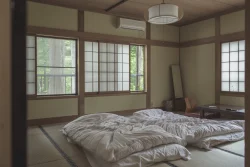
Originally published on metropolis.co.jp on May 2012

For our Metropolis Family Issue, we handed over our Upfront section to students from the British School Tokyo and Kokusai International School. Their assignment? To provide insight on life as an expat teen in Tokyo. The following stories were pitched, produced, written and edited by them. The student editorial team was led by 17-year-old Jessica Chambers.
DIY in Tokyo Town
By Jessica Edney
It’s 2012; a world where books have been replaced by Kindles, CDs by iTunes downloads and darkrooms by Instagram. We can control our iPhones with voice recognition software and Honda has designed a robot that can, erm… run backwards.
You’d think with technology evolving at such breakneck speed, nobody would bother looking back. But thanks to the large amount of apocalyptic sci-fi movies released over time, we’re all a bit wary of anything with a plug that thinks for itself.
A few years ago, my father was presented with a state-of-the-art bread machine for his birthday. His nose didn’t leave the instruction manual for hours, by which time I was so bored of hearing about the “amazing variety of dough settings” that I wanted to smash the thing into bits. Still, we were all curious to see the result, expecting a wonderful, warm aroma to fill the house at any moment.
Several hours and a burnt loaf later, the disgraced bread machine was shut in its box and never saw the light of day again. From that moment, it was declared, “The old-fashioned way is best.”
Perhaps the same notion has occurred to others, even in this urban jungle. And that’s why Jimbocho’s antique bookshops still have customers, and Shimokitazawa is crawling with record fans. Omotesando and Aoyama are also mines of independent stores, and one of my favorites (unfortunately, just for window shopping) is Bazar et Garde-Manger, near Omotesando station, exit B2. It sells beautiful things for the home, designed and made by a collection of different artists.
Even in futuristic Shinjuku, an abundance of craft shops has popped up to benefit from the rising popularity of making things by hand. One of them, Yuzuwaya, is one of eight branches dotted around Tokyo. Selling everything from beads to knitting needles, these stores cater for those (like my father) who believe that if a machine can do it, so can our hands.
Although I don’t own an iPhone and am a firm believer in paper-based novels, I would hardly give up my laptop and ride a horse to the shops. Therefore, I am infinitely happy to find myself in a city where electric towns and craft villages lie side by side.
Idol Worship
By Daniel O’Connell
All of us here are exposed to the Japanese media to some extent. But whether your daily dosage is filled with over-ecstatic food critics or limited to a couple of car ads starring Jean Reno as a futuristic feline robot, there’s no doubt that the affection the public has for celebrity is puzzling for many foreigners. Welcome to the glorification and worship of the Japanese idol.
You’ve seen them on the streets, plastered on billboards and painted as advertisements on the sides of vans. You’ve heard their music and seen them on the small screen at home and on the big screens of Shibuya Crossing. Their dances have been mimicked by millions of others across the country. From the legion-like AKB48 to housewife favorites SMAP, idols, it seems, are everywhere—whether you like it or not.
But what’s so strange about popular musicians getting famous? The difference from Western pop stars is that Japan’s idols have to do so much more. To succeed in the business, one has to be able to speak politely, make lively conversation, regularly update blogs, smile, look pretty, eat good food and yell “Oishii,” hear shocking facts and shriek “Ehhh?” plus be nice to basically everyone. In short, their endearing, hardworking personalities are shown more through their actions than through their music. But why does this happen?
The Japanese, of course, have a relatively stricter society than Western countries. That means less crime, more politeness, and, consequently, public figures that are law-abiding role models as well as sophisticated and cool. There’s a reason idols are never caught behaving badly on TV—let alone dying of drug abuse.
That’s fundamental to their success here. How could someone raised in a society of formality not be impressed by these model citizens, who somehow also manage to be young, attractive, and the next big thing?
Power Presenting
By Aryo Hadi
Did you know that some girls in India are still married off by their parents as early as the age of five? Or that a common perception of a mental hospital is that everything is white with people strapped to chairs? These were some of the topics presented by tenth graders during their Personal Projects Exhibition at K. International School Tokyo, part of their International Baccalaureate program. The students used different tools to show what they learned during their investigations. Some wrote books regarding their report, distributed brochures, and did oral presentations. One student organized a fundraising project through a social network to raise money to build water purifiers in a developing country.
It was intriguing to see why some students chose their topics. For example, one chose the topic of waterborne disease as it afflicted him personally when he was small, and continues to be a life-threatening problem in his home country of Pakistan. Another chose fitness because he has seen how unhealthy lifestyles have caused chronic diseases and illnesses in the people around him.
A powerful presentation on adolescent stress touched a nerve among the presenter’s peers for the sheer timeliness of the subject matter, since the teenage years are a time of extreme pressure and uncertainty. He mentioned that adolescence is when many changes occur in terms of academic, social, physical, cognitive, and emotional aspects. It is important for teens to learn efficient methods to manage the consequent stress. He made suggestions on how to cope including being confident, staying positive, having a strong support group made up of family and friends, being aware of your condition, and learning to manage your emotions. One important point he made is to make sure not to isolate yourself. Some teens tend to ignore their stress and engage in self-destructive activities like unhealthy eating, substance abuse and isolation, hoping the problem will go away. Some would just put their headphones on and turn their music up loud to shut the world out. Sharing your worries with people who care can help make a big difference.
This event highlighted some important issues that took us out of our bubble, impelled us to consider causes and solutions, and made us realize that the knowledge we gained here can inspire us to better ourselves and be of use to those around us. It showed us how much potential we have to make a difference in other people’s lives.

Hitting Harajuku
By Aryo Hadi
Harajuku’s Takeshita Dori is mostly known for its cosplay stores and parades of teens in costumes ranging from emo and goth to anime themes. Many die-hard Johnnys and K-Pop fans line up for their favorite idols’ novelty items in the specialty shops. Here are some places to check out as you wade through:
Murasaki Sports One of the biggest sports shops in Japan, located near the back end of Takeshita. Get the latest gear for skate- and snowboarding, soccer, and surfing. Murasaki carries popular brands such as Roxy, Burton, Hurley, Billabong, Rip Curl, and Real B Voice. They recently featured a cool collection of outdoor, traveling and street backpacks, from The North Face, Quiksilver, and Volcom to name a few (¥6,000-15,000). www.murasaki.co.jp
Pink Latte For girls into all things pink and kawaii, this whole store’s interior is pink from floor to ceiling, with a replica of a white airplane with pink flaps at the entrance. The store is crammed with kawaii Japanese stationery, clothes, bags, makeup, mobile phone accessories, and more. www.world.co.jp/pink-latte
Pet Paradise Even the pets are fashion-conscious in Harajuku. Check here for the latest doggie fashion items, including train conductor and princess costumes, kimono, and matching accessories including leads, carry bags, and beds. They have Disney and Snoopy bandanas, pooch harnesses in strawberry, ladybug, tiger, goth, and plaid themes. There’s even an earthquake survival kit for pets, with dry biscuits and pet pads inside—just in case. www.creativeyoko.co.jp
One-coin dining For those on a budget, and looking for something sweeter than the burgers at McDonald’s or Lotteria, there are also a number of crepe shops along Takeshita Dori. Mocco’s Crepe and Soft Cream Shop (3-21-20 Jingumae, Shibuya-ku; 03-6459-2050) lets you design your own crepe with whipped cream and topping from ¥300 for your first topping and ¥50 for each additional one. Try out the banana with chocolate syrup!
Getting Schooled in AKB
By Sean Nicol
Every time I go to Akihabara, I am usually on a mission to buy something. But every time, I get distracted and spend a whole bunch of time there. This is because the neighborhood is steeped in the anime culture. There is anime for everyone: Pokémon and its like for the elementary crowd; shonen (boys’) and shojo (girls’) manga and anime for high-school kids. Growing up in this environment, I couldn’t help but get interested in it.
For games, I usually go to a store called Trader Akihabara 4 (formerly Messe Sanoh; 3-14-8 Soto -Kanda, Chiyoda-ku; www.messe.gr.jp) that sells imports—a godsend if you can’t read Japanese and are impatient for new releases. My usual fare is role-playing and adventure, and anything different from the million other shooter games out there. As for figures, I head to Mandarake (3-11-12 Soto-Kanda, Chiyoda-ku; www.mandarake.co.jp), which sells all kinds of figures and old toys—a collector’s dream. My favorite figures are from a brand called S. H. Figurarts (http://meturl.com/figurarts), which aims to faithfully recreate the designs of various Japanese superheroes.
Some people get too obsessed with anime. There are people who spend their lives fawning over a certain character or spend every yen on a chracter’s merchandise. But at the same time, it’s great that kids can get into something that instills positive attitudes. A good example of this is Super Sentai or Kamen Rider. Each show encourages bravery, kindness and other qualities—and it has an effect. At least it did on me. I hold many lessons I learnt from them. They taught me about friendship (Kamen Rider Double and Fourze), a sense of right and wrong (pretty much all of them), get over my fears (Kamen Rider Kiva) and appreciate great food (Kamen Rider Kabuto). For older kids, shows like Tengen Toppa Gurren Laagan teach them to be as awesome as possible; that as sentient beings we’re constantly evolving for the better, “moving forward with every revolution [of a drill].”
I’m grateful for my upbringing in the anime culture. In the end, don’t we all just want to henshin (metamorphose), and beat the bad guys?
To Party or not to Party
By Jessica Chambers
In Japan, it’s illegal to drink and smoke before the age of 20. In many countries, this age boundary is around 16-18, so older expat teens in Japan might feel they are missing out on a lot of partying. As a 17-year-old girl, plenty of “coming-of-age” events seem to crop up every year. Here, celebrating a milestone with your friends is important. Eighteen is the age that the majority of expat teenagers leave Japan to go to college, meaning they won’t see their high-school friends again for a long time. Celebrating turning 18 as the milestone seems right for this group, as it is almost a subliminal sayonara.
In the UK, it’s common practice to have a large party for your 18th birthday. Meanwhile, for Japanese, this milestone doesn’t come until a full two years later. Which is to be celebrated? For Japanese nationals, turning 20 is a milestone as it is the legal age to vote, smoke and drink—three things that turn up the notches of freedom to 100%. For expat teens this can really be an issue. Do you abide by Japanese customs and celebrate the big 20? Or do you stick by your homeland’s customs, and have a big blowout at age 18? It is a social and legal conundrum that I’m sure many teens face.
It’s no secret that many teenagers take to the streets of Roppongi (with or without parental permission) in the latter hours of the evening. It is also no secret that many don’t. Living here has sheltered me from the usual behavior of British teenagers. Meanwhile, I have been able to have a better perspective of what goes on with my peers back home—without being in the thick of it. In Tokyo, peer pressure is very limited. It’s liberating to feel as though I am the one making the decision whether to go out in the evening, and I’m not being influenced by a large group of rowdy youths with alco-pops. Being an expat teen in Tokyo has allowed me to live the life, without feeling uncomfortable about going out and getting drunk before I’m ready. There’s pressure to wear the right clothes, say the right things—but isn’t that the case with every social group? Overall, living as an expat teen has allowed me to mature as and when I wanted to—something I doubt I could have done back home.
Expat Connection
By Naomi Takahashi
After fourteen years of living in Bristol, a medium sized city in the UK, I was a bit apprehensive about moving to Tokyo, the world’s busiest metropolitan area. I was worried about what people were going to be like, the massive cultural jump, and the thought of “starting over.” When the time arrived and I had a chance to settle in, I noticed that the schooling environment and the expat kids were very different from the schools and kids I left behind.
Everyone I’ve met here has an unexplainable spark and drive, something that I never really saw in the UK. People here are so proactive, they want to get out there. With lots of unique charity opportunities and sporting and social events, that’s not surprising.
Living overseas (even with the inevitable language barrier) provides kids with many extracurricular opportunities and opens their horizons to other directions they can follow. Before moving to Tokyo I was only thinking about universities in South West England. Now, I’m considering studying in America, a country I have never been to. Expat communities have a great level of diversity. Along with the open-mindedness of people, bullying is a rare occurrence. Of course it isn’t completely absent, but you hear about it far less than you do in the UK.
A key point of international education is that there is a far wider range of available curricula to choose from. This is crucial if a student is in the middle of a several-year course, allowing them to follow a curriculum that might not be readily available in their home country. The international baccalaureate, SAT, and what I take, the A-levels, are all available, broadening horizons for later life.
On a final note, people may be thinking, “With the culture being so different, doesn’t it take a while to settle into Tokyo?” My answer is that moving anywhere, even a few miles away, takes some getting used to. Granted, somewhere on the other side of the world is going to take longer but living in such a diverse and exciting culture is an amazing opportunity. I would recommend it to anyone who gets the chance.
Tokyo Vogue
By Jessica Armstrong
In Tokyo, fashion individuality is celebrated rather than shunned, and that’s what makes it such an interesting city to live in. If you head into Shibuya you are guaranteed to see checked shirts, skinny jeans and bleached-blonde hair—and that’s just the men we’re talking about.
Designers and photographers flock to Tokyo’s busy streets to pick up on the latest trends, from floral skirts to flared jeans. Colored jeans and patterned tights, for example, were trendy here before going global. Beyond the over-the-top gyaru and Lolita girls, there are skirts paired with trousers, over-processed hair, pointy shoes, and even socks and sandals, considered a serious fashion faux pas back in the UK.
To find the latest and most daring outfits you need to head to less popular areas. Like many a teen in Tokyo, I often find myself wandering around the streets of Tokyo on the weekends, hunting for those one-of-a-kind shops filled with clothes that not only push boundaries but also bring back trends. Shimokitazawa is the perfect place to spend the weekend exploring; its narrow, twisty streets offer food, music and clothes galore at bargain prices.
In the UK, these getups are only to be found in edgy districts such as London’s Camden, but in Tokyo teen fashion can flourish. Teenagers can often feel pressure to fit in, stick to current trends, with anything else seen as outdated. But being exposed to such a wonderful variety of styles and combinations rubs off on you after a while. Expats often find themselves wearing outfits they would never have dreamed of before moving to Tokyo. Fashion in Tokyo is what fashion is meant to be: free.







